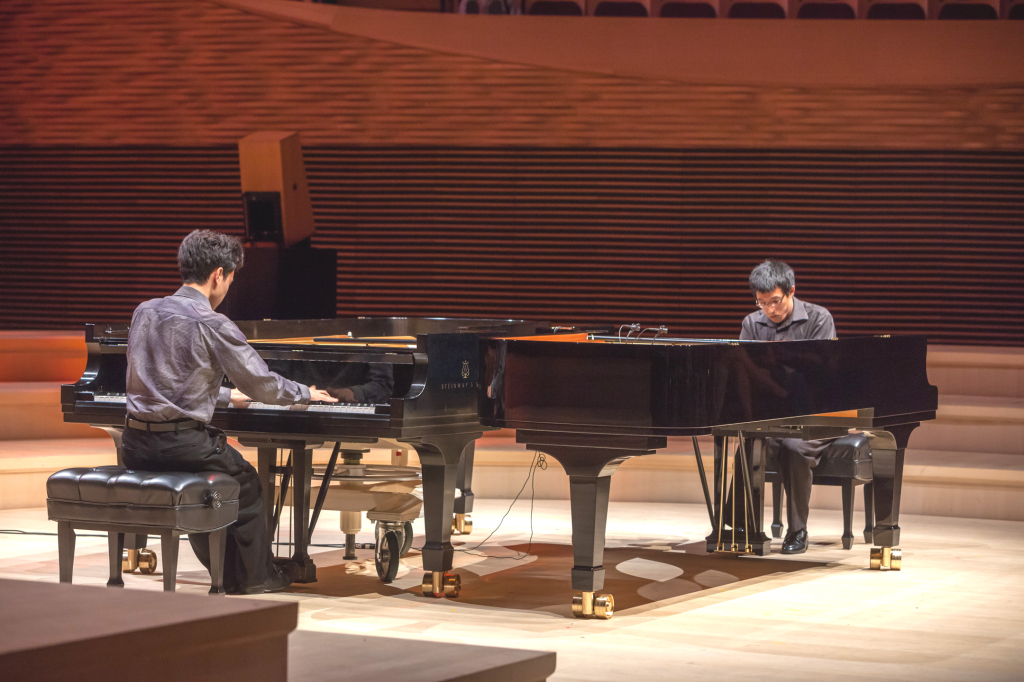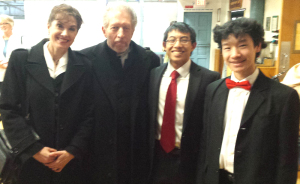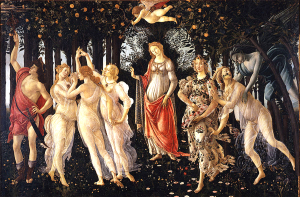
THE HAPPY DOG DUO, Eric Tran, left, and Nathan Cheung, performed with Vallejo Symphony Orchestra on Sunday.
Courtesy VSO
VSO Director David Ramadanoff warmed up the afternoon audience with interesting and amusing descriptions of the classic works for piano and orchestra, beginning with Respighi’s “La Primavera,” which the composer based on the famous painting of the same name by Botticelli. “Respighi captures, for me, the feeling of the very beginning of spring. The sights and smells invite you to step out and enjoy,” Ramadanoff related. “You’ll hear the wind blowing through the trees, then a horn calls us to come out and play.”
The VSO’s violin component was spot-on Sunday, opening the piece brilliantly with a beautiful depiction of gentle wind rustling the leaves as it passes through trees freshly awoken from their winter sleep. A quiet flute sound rounded out the effect, a feeling that was at once soothing and exciting. Equally evocative was the sound of the bassoon, which stood out as representative of a dancer celebrating the season. As the piece transitions into a set of varying dance movements, the tempo begins to change repeatedly until culminating with a full and assertive “ta-da!” finale, which boomed dramatically through the auditorium.
“Primavera” also provided a glimpse of the tremendous agility and sensitivity of VSO pianist Marc Shapiro. Tucked away to the rear of the ensemble for this piece, the piano sound carried beautifully, providing a fine complement to Respighi’s extraordinary salute to the magic of springtime.Next on the Sunday program was Prokofiev’s “Peter and the Wolf,” a playful annotation of the fairytale in which young Peter ignores his grandfather’s cautioning and wanders into a meadow where wolves are known to prowl.
“When I first heard ‘Peter’ (as a child), I was caught by how Prokofiev wrote for the instruments that described the animals so well,” Ramadanoff recalled in his “Know the Score” talk an hour before the performance. “I was captivated.” The conductor treated the audience to a part-by-part demonstration of the various sound effects in the story. “The part of the bird will be played by the flutes, like this,” he began, as a flute played a segment of birdsong sound. “And here’s the duck, played by the oboe,” and so forth. The elementary lesson brought the audience into the realm of childhood storytelling, the perfect frame of mind for full appreciation of the piece, a celebration of the art of the story and the imagination of children.
“Peter and the Wolf” was conducted Sunday by Assistant Conductor Pamela Martin, and narrated by actor, director, playwright and musician Corey Fischer, perhaps best known for his acting parts in early Robert Altman films and several 1970s TV sitcoms including “M*A*S*H,” “All in the Family” and “Barney Miller.” Martin’s conducting style was exciting and fluid, and the narration folded in comfortably without any sense of abrupt interruption. Fischer’s voice is smooth and sculpted, and his range and tempo proved a fitting complement to the symphonic tale.
“‘All is quiet,’ chirped the bird, ‘All is quiet, all is quiet,’” he read, followed by sweet sounds from the flute. “Then a duck came waddling round,” he told, as the oboe came in with lower-register quacking sounds. Some of the most carefree moments in the piece come as the duck and the bird are heard to argue, a clear tonal image with a delightful, playful pace, contrasted with the mildly ominous sound of the wolf later approaching the oblivious Peter, a building sound of trembling cello and bass.Rimsky-Korsakov’s “Flight of the Bumblebee,” flawlessly executed, kicked off the second half. The symphony’s pristine performance left the audience breathless — so swift and pure that it seemed by the time listeners had a moment to contemplate the wonder of it, it was finished.
Following “Bumblebee,” two striking concert grand pianos were literally brought to the forefront of the Hogan stage, one nestled behind the other so the Happy Dog Duo, Eric Tran and Nathan Cheung, could face each other. It was a sight to behold, creating the illusion of one ultra-long instrument with a keyboard at either end.
These two young performers, both in the process of earning their professional degrees, are most certainly bound for success. Tran has already won impressive awards, including Stanford University’s Robert M. Golden Medal for Artistic Creation in Music in 2013 and an earlier Humanities and Sciences Undergraduate Award for his composition, “Fantasia for Violin and Piano.” He is currently a master’s candidate at the San Francisco Conservatory of Music.
Cheung is currently a senior at Stanford, majoring in music with concentration in piano performance and composition. He too has won numerous performance awards, including the Baldini Prize from the national Mondavi Young Artist Competition. Cheung is currently preparing for his final senior piano recital while at the same time working to complete a minor in Asian-American studies by the end of the current school term.
With the duo on piano, the symphony rounded out Sunday afternoon’s performance with the most glorious selection on the day’s musical menu, “Carnival of the Animals” by Camille Saint-Saëns. The piece was also the best vehicle for the two guest pianists to demonstrate their impressive range of abilities.
“Saint-Saëns lived an incredibly long life,” Ramadanoff began his introduction to the piece. “Born eight years after Beethoven died, he lived into the 20th century to hear Debussy and Stravinsky — which he detested,” the conductor quipped. “A serious composer as well as an avid scientist, Saint-Saëns wrote ‘Carnival of the Animals’ simply to delight his friends and students.”

PAMELA MARTIN, David Ramadanoff, Nathan Cheung and Eric Tran at a post-concert reception hosted by the Vallejo Yacht Club.
Elizabeth Warnimont photo
The most delightful movement in “Carnival,” though, must certainly be Part VII, “Aquarium,” which features rippling sounds from the pianos, rich and lovely “swimming” violins, and the aural image of light sparkling on the water’s surface provided by glockenspiel. For those moments especially, the entirety of the orchestra Sunday was simply astonishing.
Congratulations once again to the Vallejo Symphony, a unique band that comes together apart from each musician’s outisde professional obligations to bring beautiful and inspiring music to Vallejo and surrounding communities. As evidenced by an only two-thirds-full auditorium Sunday, the symphony is a gem as yet largely undiscovered.
Come and see conductor Ramadanoff’s final concert at the helm of the VSO on April 12, after which many new faces will fill the orchestra’s seats. Let’s give the beloved maestro a well-earned symphonic send-off, deserving of his immense contribution to our community over the past 30-plus years. There will be room for everyone at the larger-capacity Landers Hall — come on, let’s fill ’er up.
If You Go
The next performance of the Vallejo Symphony will be at Landers Hall, 1310 Club Drive, Mare Island, Vallejo on Sunday, April 12. “Serenité” will feature works by Bartok, Debussy, Ravel and others. Tickets are $15 to $35 and are available by calling 643-4441 or online at vallejosymphony.org.
Elizabeth Warnimont is a freelance writer specializing in the performing arts. She is also a substitute teacher for the Benicia Unified School District.








Leave a Reply